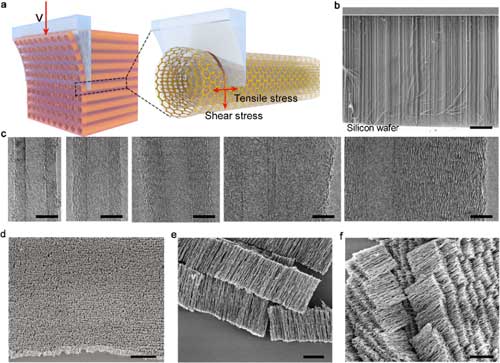| Posted: Aug 09, 2017 | |
Precisely cutting carbon nanotubes(Nanowerk News) In new work, reported in ACS Nano ("The Deformations of Carbon Nanotubes under Cutting"), researchers demonstrate how multiwalled carbon nanotubes (MWCNTs) with controllable sizes are cut precisely along the radial direction, and the structural evolution is efficiently investigated through a combination of geometry phase analysis and first-principle calculation. |
|
| Generally, a nanoscaled object or a molecule is stabilized at one end by a substrate, while the other end is pulled to break it. For instance, carbon nanotubes have been pulled to elongate and break along the length direction. | |
| However, the difficulty of controlling the breaking point hinders more effective analysis. | |
| Alternatively, a shear force can be accurately applied at a specific position of an object to deform it; however, a shear force is rarely used to break nanomaterials because of the difficulty in precision cutting and rational analyzing structural evolution using currently available technologies. | |
 |
|
| Schematic and structural characterization of sliced multiwalled carbon nanotubes. (a) Schematic illustration of the slicing process of aligned MWCNTs. (b) Side views of scanning electron microscopy (SEM) image of aligned MWCNTs. Scale bar, 100 µm. (c) MWCNTs with increasing diameters of 8, 10, 15, 40, and 65 nm (from left to right). Scale bar, 5 nm. (d) SEM image of a layer of sliced MWCNTs. Scale bar, 5 µm. (e and f) Side views of SEM images of sliced MWCNTs arrays. Scale bar, 3 µm. (© ACS) (click on image to enlarge) | |
| In this present paper, the scientists study the structural evolution of conjugated carbon atoms by synthesizing tailorable MWCNTs as an effective model. | |
| They find that the lattice deformation depends on the anisotropy, chirality, curvature, and slicing rate. In particular, understanding plastic breaking mechanism and the atomic transformations with the impacts of strain rate and initial lattices help to actually reveal a plastic breaking mechanism for both nondoped and doped MWCNTs under cutting. | |
| "This method may be extended as a general strategy for the characterizations of shear deformations in nanomaterials," the authors conclude. "The resulting sliced carbon nanotubes with controllable sizes and open ends are promising for various applications, for example, as an anode material for lithium-ion batteries." |
 By
Michael
Berger
– Michael is author of three books by the Royal Society of Chemistry:
Nano-Society: Pushing the Boundaries of Technology,
Nanotechnology: The Future is Tiny, and
Nanoengineering: The Skills and Tools Making Technology Invisible
Copyright ©
Nanowerk LLC
By
Michael
Berger
– Michael is author of three books by the Royal Society of Chemistry:
Nano-Society: Pushing the Boundaries of Technology,
Nanotechnology: The Future is Tiny, and
Nanoengineering: The Skills and Tools Making Technology Invisible
Copyright ©
Nanowerk LLC
|
|
|
Subscribe to a free copy of one of our daily Nanowerk Newsletter Email Digests with a compilation of all of the day's news. |
